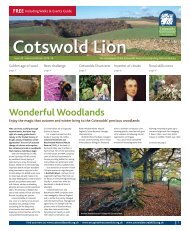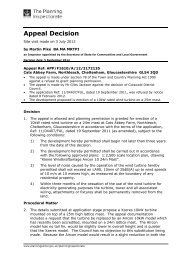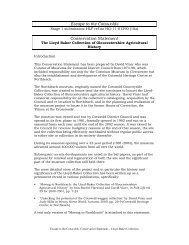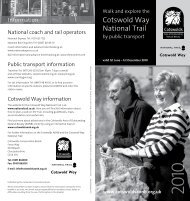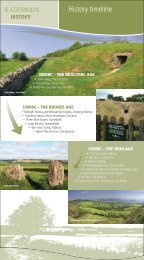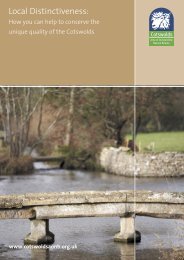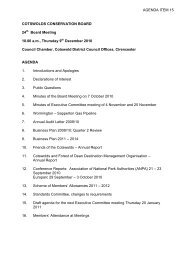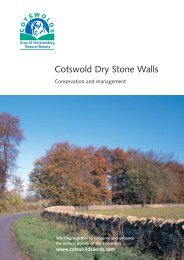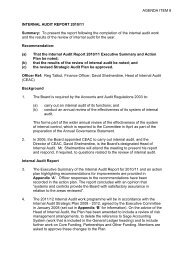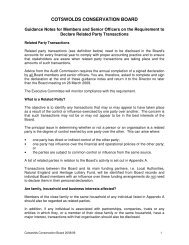AONB LCAR S1 P1-10 FINAL - the Cotswolds Area of Outstanding ...
AONB LCAR S1 P1-10 FINAL - the Cotswolds Area of Outstanding ...
AONB LCAR S1 P1-10 FINAL - the Cotswolds Area of Outstanding ...
Create successful ePaper yourself
Turn your PDF publications into a flip-book with our unique Google optimized e-Paper software.
2 Evolution <strong>of</strong> <strong>the</strong> Landscape<br />
Biodiversity<br />
• There has been an irreplaceable loss <strong>of</strong> semi-natural<br />
habitats including areas <strong>of</strong> common land and species rich<br />
limestone grassland, now converted to arable production.<br />
• Loss <strong>of</strong> wetland, water meadows and river margin<br />
habitats has occurred as a result <strong>of</strong> <strong>the</strong> effects <strong>of</strong><br />
nitrate-rich run <strong>of</strong>f, abstraction, and drainage associated<br />
with agricultural intensification.<br />
Development Pressures<br />
• Despite stringent controls <strong>of</strong> building development,<br />
<strong>the</strong>re is evidence <strong>of</strong> inappropriate materials, style<br />
and layouts that do not accord with <strong>the</strong> ‘Cotswold<br />
vernacular’. These adversely affect <strong>the</strong> o<strong>the</strong>rwise<br />
remarkable unity and charm <strong>of</strong> <strong>the</strong> many settlements.<br />
• Pressure for edge development can adversely affect<br />
<strong>the</strong> historic form <strong>of</strong> <strong>the</strong> villages and mask <strong>the</strong> direct<br />
relationship with geology, landform and land use.<br />
Inappropriate village edge development can <strong>of</strong>ten<br />
have a significant impact on <strong>the</strong> wider landscape<br />
setting <strong>of</strong> a settlement.<br />
• Within <strong>the</strong> rural landscape, an increasing number <strong>of</strong><br />
modern, industrial scale farm buildings constructed<br />
in prefabricated materials conflict in form and scale<br />
with <strong>the</strong> more traditional <strong>Cotswolds</strong> stone barns.<br />
• At a local level, <strong>the</strong>re is evidence <strong>of</strong> a creeping<br />
‘suburbanisation’ within house curtilages, within which<br />
<strong>the</strong>re is no direct control eg window design and garden<br />
treatments. Such changes, whilst having only a minimal<br />
impact locally, when viewed over a wide area, can have<br />
a significant impact on how a landscape is perceived.<br />
• Demands for new housing both from affluent ‘incomers’<br />
and young local people will continue to exert pressure<br />
to establish new housing. There is a need for affordable<br />
housing in particular to ensure that rural communities<br />
can remain intact.<br />
• Within agricultural land, <strong>the</strong> construction <strong>of</strong> modern and<br />
<strong>of</strong>ten large ‘industrial’ scale agricultural buildings impact<br />
on <strong>the</strong> landscape and contrast with <strong>the</strong> more traditional<br />
vernacular stone farmsteads and field barns.<br />
32<br />
<strong>Cotswolds</strong> <strong>AONB</strong> Partnership<br />
Quarrying<br />
• As recently as <strong>the</strong> 1930s numerous Cotswold quarries<br />
were still being worked by hand. In <strong>the</strong> post war period,<br />
however, a limited number <strong>of</strong> larger scale mechanical<br />
quarries have been established in response to increased<br />
demand for crushed aggregate for road building, as well<br />
as <strong>the</strong> continued requirement for locally sourced<br />
‘dimension’ stone for building purposes.<br />
• Compared to <strong>the</strong> number <strong>of</strong> quarries that once extended<br />
across <strong>the</strong> <strong>Cotswolds</strong>, <strong>the</strong> remaining working quarries<br />
are relatively small in number. They are large in scale,<br />
and <strong>the</strong>refore likely to affect, and be visible from <strong>the</strong><br />
surrounding area for a long period. Quarries are generally<br />
located in fairly remote areas, however, and detached from<br />
settlements. As a consequence <strong>the</strong>ir ‘area <strong>of</strong> influence’ is<br />
confined, but <strong>the</strong> effects <strong>of</strong> heavy traffic generated through<br />
quarrying activities is a source <strong>of</strong> potential disturbance.<br />
Infrastructure<br />
• Following <strong>the</strong> publication <strong>of</strong> <strong>the</strong> Beeching Report in <strong>the</strong><br />
1960s, <strong>the</strong> network <strong>of</strong> minor railway lines that crossed<br />
<strong>the</strong> <strong>AONB</strong> was significantly reduced, leaving a legacy<br />
<strong>of</strong> disused railway lines. Some <strong>of</strong> <strong>the</strong>se have been<br />
absorbed into agricultural land, o<strong>the</strong>rs still bear witness<br />
to <strong>the</strong>ir earlier function with embankments and cuttings<br />
still crossing <strong>the</strong> landscape, and remnants <strong>of</strong> bridges<br />
remaining. The railway perimeters are <strong>of</strong>ten rich in<br />
wildlife interest.<br />
TELECOMMUNICATIONS MAST ON THE COTSWOLDS<br />
HIGH WOLD<br />
• A number <strong>of</strong> major infrastructure elements, notably high<br />
voltage power lines and telecommunication masts, have<br />
been erected within <strong>the</strong> <strong>AONB</strong> and where <strong>the</strong>y occur,<br />
<strong>the</strong>se large vertical elements have a major impact on<br />
<strong>the</strong> landscape. In recent years, a growing number <strong>of</strong><br />
radio and mobile phone masts presents a fur<strong>the</strong>r impact<br />
on <strong>the</strong> landscape and a threat to landscape character.



